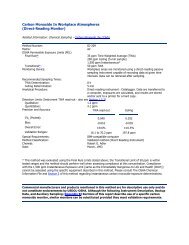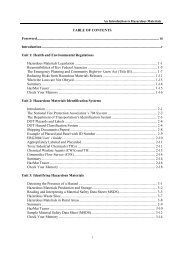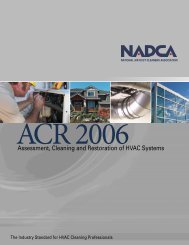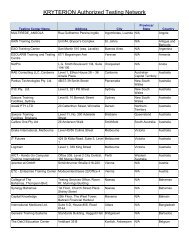Dampness and Mould - WHO guidelines for indoor air quality - PRWeb
Dampness and Mould - WHO guidelines for indoor air quality - PRWeb
Dampness and Mould - WHO guidelines for indoor air quality - PRWeb
Create successful ePaper yourself
Turn your PDF publications into a flip-book with our unique Google optimized e-Paper software.
MOISTURE CONTROL AND VENTILATION<br />
61<br />
to clean when contaminated. Heavy wall-to-wall carpeting is a risk factor in a<br />
humid climate.<br />
Indoor <strong>air</strong> dehumidification can be used, in which dehumidified <strong>air</strong> is circulated<br />
through a cooling coil, where water is condensed <strong>and</strong> drained. After cooling<br />
<strong>and</strong> dehumidification, the <strong>air</strong> can be heated with the same device back to<br />
room temperature. These devices are particularly useful <strong>for</strong> temporary applications.<br />
From the st<strong>and</strong>point of energy use, it is important that <strong>air</strong> be dehumidified<br />
to a relative humidity not much lower than the limit value <strong>for</strong> the growth of mites<br />
(45%).<br />
The main methods <strong>for</strong> preventing moisture in buildings are summarized in<br />
Figure 8.<br />
3.10 Conclusions <strong>and</strong> recommendations<br />
While microbial growth <strong>and</strong> health outcomes are consequences, their common<br />
denominator is undesired moisture behaviour (i.e. excess moisture in building<br />
assemblies or on surfaces). The reasons <strong>for</strong> the presence of mould <strong>and</strong> mites are<br />
the same all over the world, but the methods of control may differ. Water intrusion,<br />
dampness <strong>and</strong> moisture-related phenomena are not only harmful <strong>for</strong><br />
Figure 8. Controlling moisture through building design <strong>and</strong> construction<br />
(1) Drain rainwater <strong>and</strong><br />
5<br />
3<br />
surface water from near<br />
the building. (2) Drain<br />
13<br />
the foundations with<br />
an underground pipe.<br />
4<br />
9<br />
(3) Install a tilted (rather<br />
11 than a flat) roof in wet<br />
10<br />
climates. (4) Install eaves<br />
to protect walls from<br />
rain. (5) Install watertight<br />
6<br />
piping penetrating<br />
8<br />
the roof. (6) Install good<br />
ventilation, especially<br />
1<br />
7<br />
in bathrooms, laundry<br />
1<br />
rooms <strong>and</strong> kitches.<br />
2<br />
12 (7) Install watertight,<br />
sloping floors with floor<br />
drains in wet-process<br />
rooms. (8) Prevent condensation on walls <strong>and</strong> windows. (9) Install vapour barriers in walls. (10)<br />
Use good, watertight window construction, including window sills. (11) Drain rainwater from<br />
the roof. (12) Protect against frost when applicable. (13) Ventilate attics <strong>and</strong> crawl spaces when<br />
applicable.






